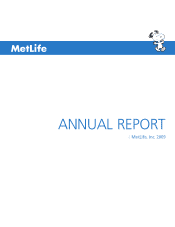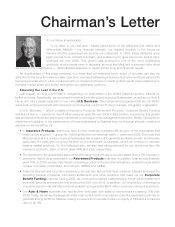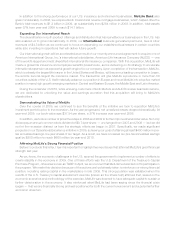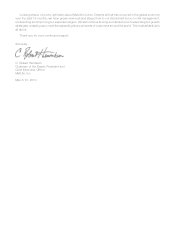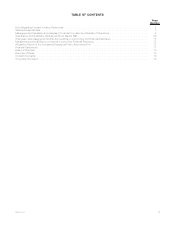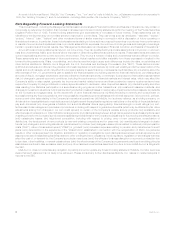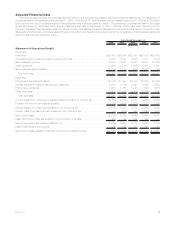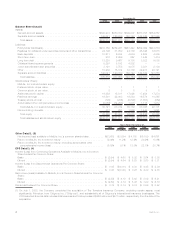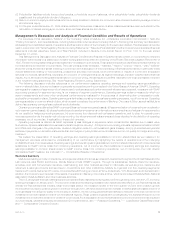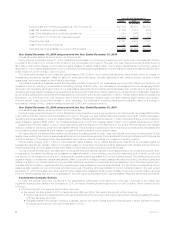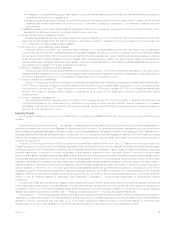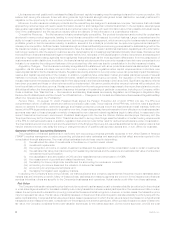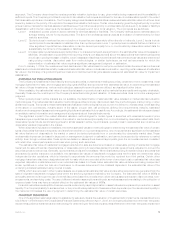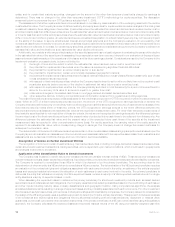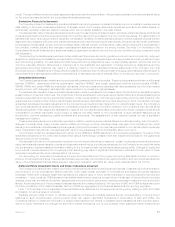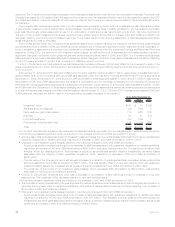MetLife 2009 Annual Report Download - page 11
Download and view the complete annual report
Please find page 11 of the 2009 MetLife annual report below. You can navigate through the pages in the report by either clicking on the pages listed below, or by using the keyword search tool below to find specific information within the annual report.(2) Policyholder liabilities include future policy benefits, policyholder account balances, other policyholder funds, policyholder dividends
payable and the policyholder dividend obligation.
(3) Return on common equity is defined as net income (loss) available to MetLife, Inc.’s common shareholders divided by average common
stockholders’ equity.
(4) For the year ended December 31, 2009, shares related to the exercise or issuance of stock-based awards have been excluded from the
calculation of diluted earnings per common share as these shares are anti-dilutive.
Management’s Discussion and Analysis of Financial Condition and Results of Operations
For purposes of this discussion, “MetLife” or the “Company” refers to MetLife, Inc., a Delaware corporation incorporated in 1999 (the
“Holding Company”), and its subsidiaries, including Metropolitan Life Insurance Company (“MLIC”). Following this summary is a discussion
addressing the consolidated results of operations and financial condition of the Company for the periods indicated. This discussion should be
read in conjunction with “Note Regarding Forward-Looking Statements,” “Selected Financial Data” and the Company’s consolidated financial
statements included elsewhere herein and “Risk Factors” included in MetLife, Inc’s Annual Report on Form 10-K for the year ended
December 31, 2009.
This Management’s Discussion and Analysis of Financial Condition and Results of Operations may contain or incorporate by reference
information that includes or is based upon forward-looking statements within the meaning of the Private Securities Litigation Reform Act of
1995. Forward-looking statements give expectations or forecasts of future events. These statements can be identified by the fact that they do
not relate strictly to historical or current facts. They use words such as “anticipate,” “estimate,” “expect,” “project,” “intend,” “plan,” “believe”
and other words and terms of similar meaning in connection with a discussion of future operating or financial performance. In particular, these
include statements relating to future actions, prospective services or products, future performance or results of current and anticipated
services or products, sales efforts, expenses, the outcome of contingencies such as legal proceedings, trends in operations and financial
results. Any or all forward-looking statements may turn out to be wrong. Actual results could differ materially from those expressed or implied
in the forward-looking statements. See “Note Regarding Forward-Looking Statements.”
The following discussion includes references to our performance measures operating earnings and operating earnings available to
common shareholders, that are not based on generally accepted accounting principles in the United States of America (“GAAP”). Operating
earnings is the measure of segment profit or loss we use to evaluate segment performance and allocate resources and, consistent with GAAP
accounting guidance for segment reporting, is our measure of segment performance. Operating earnings is also a measure by which our
senior management’s and many other employees’ performance is evaluated for the purposes of determining their compensation under
applicable compensation plans. Operating earnings is defined as operating revenues less operating expenses, net of income tax. Operating
earnings available to common shareholders, which is used to evaluate the performance of Banking, Corporate & Other, as well as MetLife is
defined as operating earnings less preferred stock dividends.
Operating revenues is defined as GAAP revenues (i) less net investment gains (losses), (ii) less amortization of unearned revenue related to
net investment gains (losses), (iii) plus scheduled periodic settlement payments on derivative instruments that are hedges of investments but
do not qualify for hedge accounting treatment, (iv) plus income from discontinued real estate operations, and (v) plus, for operating joint
ventures reported under the equity method of accounting, the aforementioned adjustments and those identified in the definition of operating
expenses, net of income tax, if applicable to these joint ventures.
Operating expenses is defined as GAAP expenses (i) less changes in experience-rated contractholder liabilities due to asset value
fluctuations, (ii) less costs related to business combinations (since January 1, 2009) and noncontrolling interests, (iii) less amortization of DAC
and VOBA and changes in the policyholder dividend obligation related to net investment gains (losses), and (iv) plus scheduled periodic
settlement payments on derivative instruments that are hedges of policyholder account balances but do not qualify for hedge accounting
treatment.
We believe the presentation of operating earnings and operating earnings available to common shareholders as we measure it for
management purposes enhances the understanding of our performance by highlighting the results of operations and the underlying
profitability drivers of our businesses. Operating earnings and operating earnings available to common shareholders should not be viewed as
substitutes for GAAP income (loss) from continuing operations, net of income tax. Reconciliations of operating earnings and operating
earnings available to common shareholders to GAAP income (loss) from continuing operations, net of income tax, the most directly
comparable GAAP measure, are included in “— Consolidated Results of Operations.”
Executive Summary
MetLife is a leading provider of insurance, employee benefits and financial services with operations throughout the United States and the
Latin America, Asia Pacific and Europe, Middle East and India (“EMEI”) regions. Through its subsidiaries, MetLife offers life insurance,
annuities, auto and homeowners insurance, retail banking and other financial services to individuals, as well as group insurance and
retirement & savings products and services to corporations and other institutions. MetLife is organized into five operating segments:
Insurance Products, Retirement Products, Corporate Benefit Funding and Auto & Home (collectively, “U.S. Business”) and International. In
addition, the Company reports certain of its results of operations in Banking, Corporate & Other, which is comprised of MetLife Bank, National
Association (“MetLife Bank”) and other business activities.
The U.S. and global financial markets experienced extraordinary dislocations during late 2008 through early 2009, with the U.S. economy
entering a recession in January 2008. The economic crisis and the resulting recession have had an adverse effect on our financial results, as
well as the financial services industry. Most economists believe the recession ended in the third quarter of 2009 when positive growth
returned and now expect positive growth to continue through 2010. We have experienced an increase in market share and sales in some of
our businesses from a flight to quality in the industry. In addition, the recovering global financial markets contributed to the improvement in net
investment income and sales in most of our international regions. These positive impacts were outweighed by the adverse effects on our net
investment income and the demand for certain of our products. For a discussion of how the financial and economic environment has impacted
our 2009 results, capital and liquidity, and expected 2010 performance, see “— Results of Operations,” “— Liquidity and Capital Resources”
and “— Consolidated Company Outlook.”
5MetLife, Inc.

